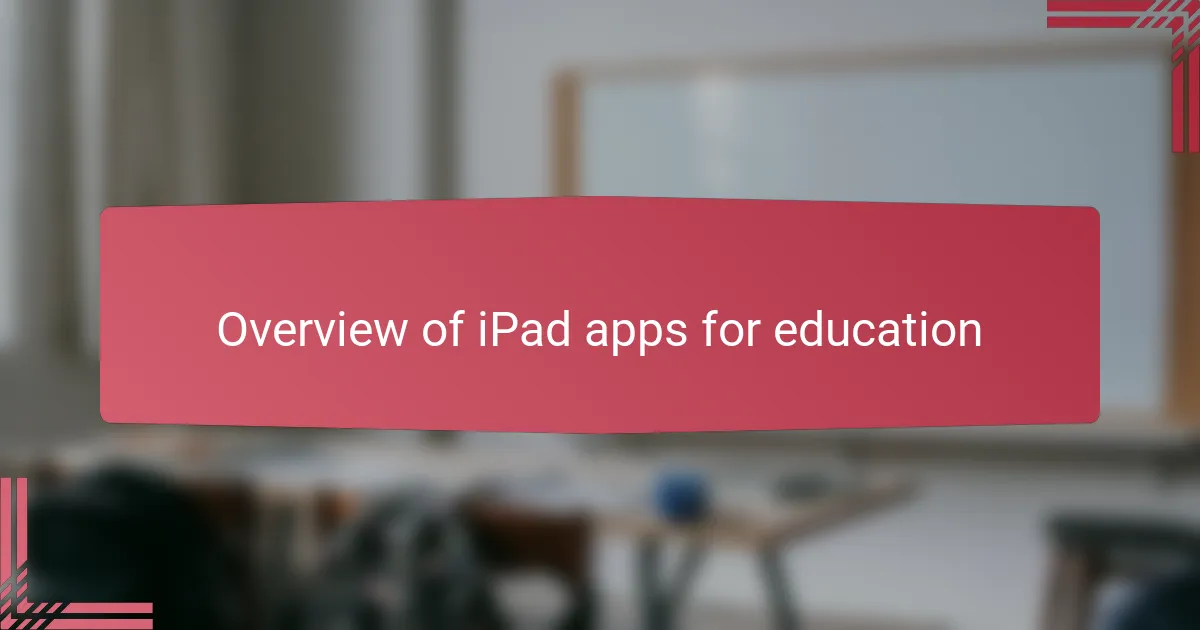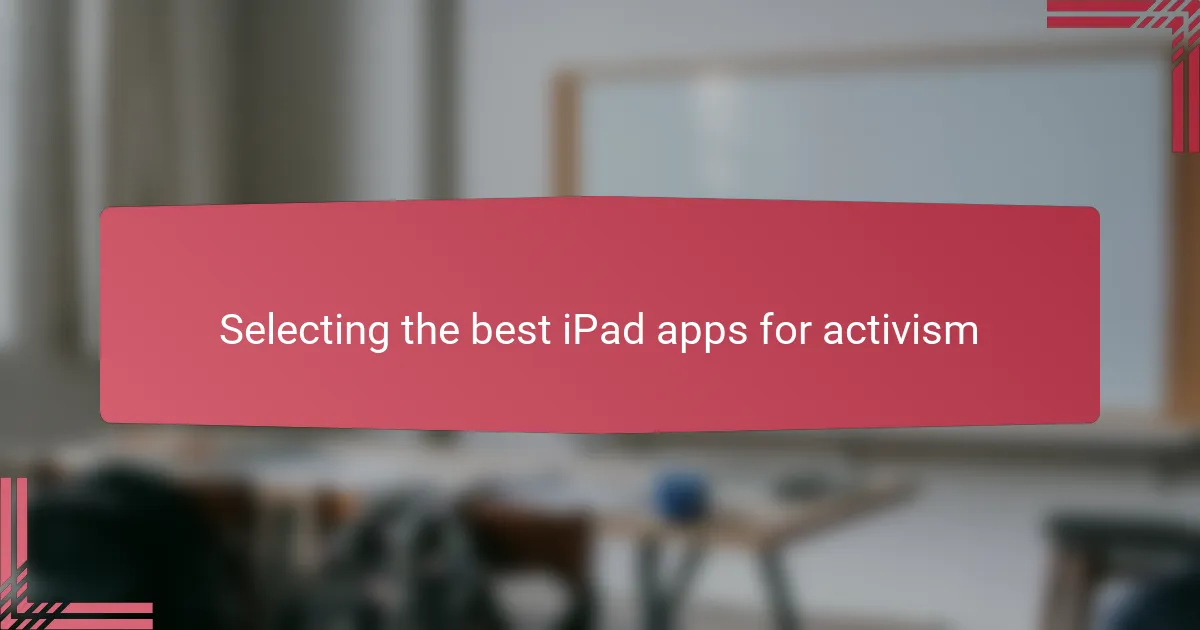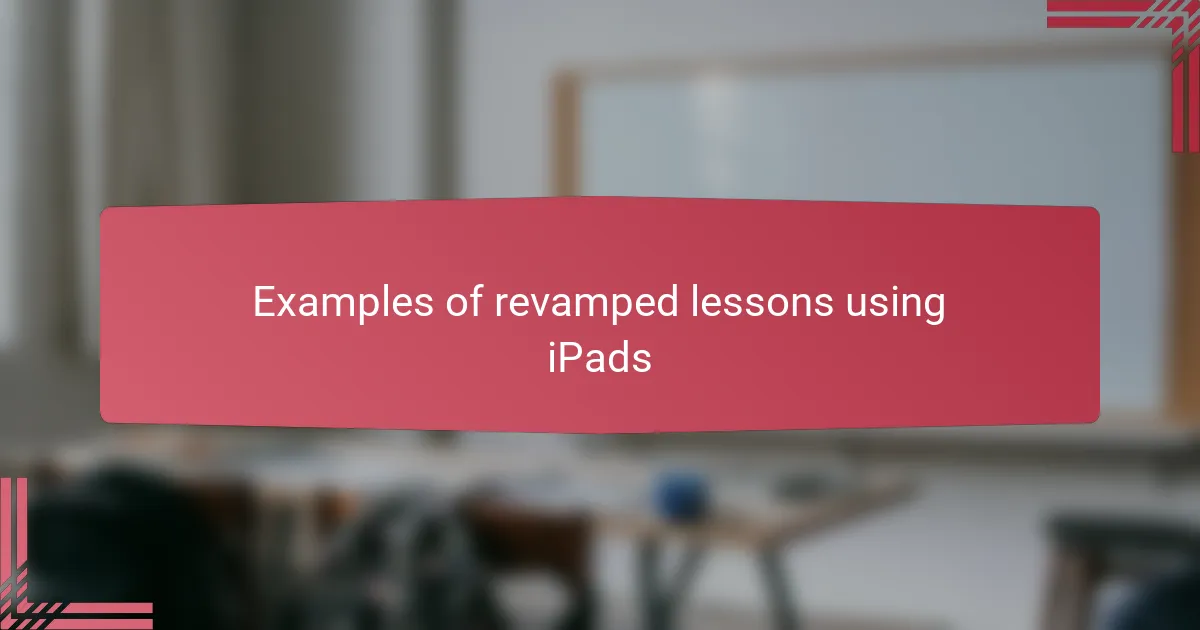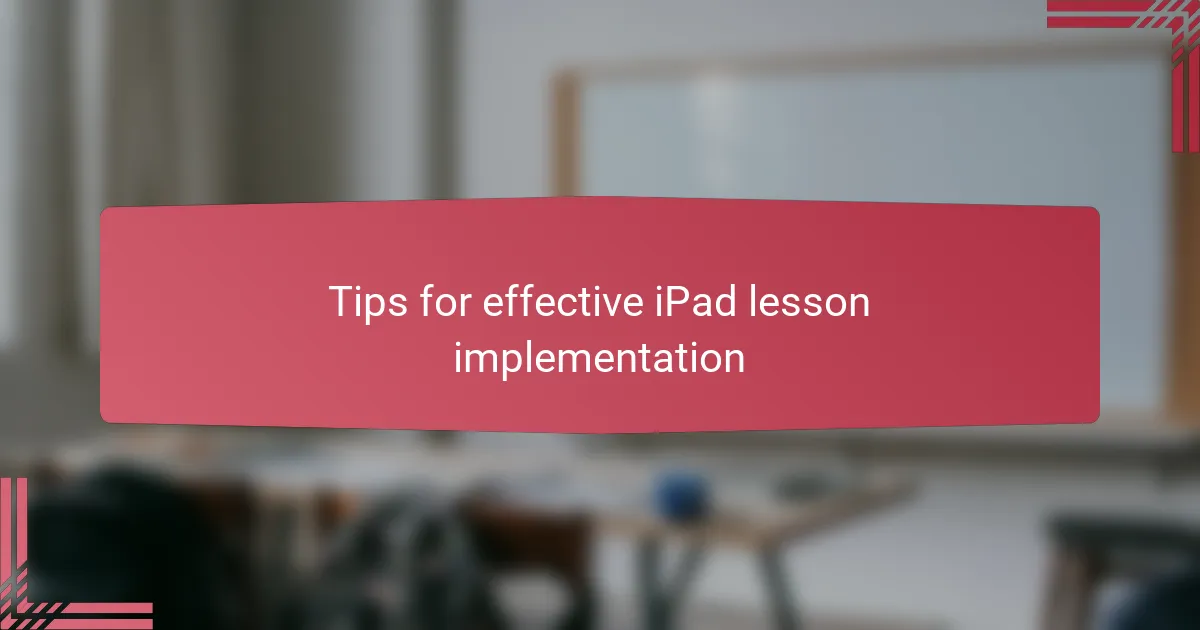Key takeaways
- Activist teacher resources prioritize critical thinking and social justice, fostering student engagement and empowerment.
- iPad apps enhance learning by accommodating diverse learning styles, promoting creativity, and encouraging active participation rather than passive learning.
- Selecting the right apps involves ensuring they promote critical engagement, are accessible, and align with activist educational goals.
- Effective integration of apps into lessons requires intentional planning, balancing technology with face-to-face dialogue, and allowing for reflection afterwards.

Understanding activist teacher resources
Activist teacher resources are more than just lesson plans—they’re tools for empowerment. When I first explored these materials, I found myself challenged to rethink how I approach sensitive topics in the classroom. Have you ever wondered how education can spark real change rather than just convey information?
What makes these resources stand out is their focus on critical thinking and social justice. I’ve seen firsthand how they encourage students to question the status quo and voice their own experiences. It’s not always easy, but isn’t that the point of true activism—pushing boundaries and embracing discomfort to grow?
Using activist resources means committing to ongoing learning as a teacher. I often reflect on my biases and gaps, realizing that this work demands vulnerability and honesty. Can education truly be transformative without that kind of reflection layered into the teaching process?

Overview of iPad apps for education
When I first started integrating iPad apps into my lessons, I was amazed at how many options there were—each designed to engage students in unique ways. From interactive storytelling tools to collaborative brainstorming platforms, these apps offer more than just digital worksheets; they invite active participation. Have you noticed how a well-chosen app can transform passive listening into hands-on learning?
What really struck me, though, was how these tools support diversity in learning styles. Some apps cater to visual learners with vibrant graphics, while others support verbal or kinesthetic learners through recording features or touch interaction. It made me realize that using iPad apps isn’t just about tech—it’s about meeting students where they are and amplifying their voices.
Of course, not every app fits every lesson or classroom culture, which led me to experiment and reflect constantly. How do I balance technology with meaningful dialogue? For me, the answer lies in apps that encourage critical thinking rather than just deliver content—because true learning, especially in activist education, happens when students are challenged to question and create.

Benefits of using iPad apps in lessons
One of the biggest benefits I noticed when I started using iPad apps in my lessons was how they brought my students’ energy to life. Instead of just listening or taking notes, they could interact with content directly—drawing, recording, and collaborating in ways that felt natural and exciting. Have you ever watched a student’s excitement grow when they see their ideas taking shape on a screen? For me, those moments made the classroom feel charged with possibility.
Another thing I appreciate is how these apps help me personalize learning much more easily. Different students express their understanding in different ways, and apps let me accommodate that without extra work piling up. When I see a student who struggles with written assignments create a powerful spoken word project or a visual storyboard through an app, it reminds me why flexibility matters so much—especially when teaching about complex social issues.
But beyond engagement and personalization, I found that iPad apps cultivate skills we often overlook: critical thinking, creativity, and digital literacy. These aren’t just tech skills; they’re essential for students to navigate and challenge the world around them. How often do we get the chance to embed activism and technology seamlessly? Using apps gave me a way to do both, making lessons richer and more relevant in ways traditional methods rarely achieve.

Selecting the best iPad apps for activism
Choosing the right iPad apps for activism felt like a puzzle at first. I wanted tools that didn’t just deliver information but invited students to question and connect deeply with social issues. Have you ever sifted through countless apps only to realize most lack that spark of critical engagement? I found that apps with collaborative features or storytelling capabilities made the biggest difference—they invited students to co-create knowledge rather than passively consume it.
Another important factor for me was accessibility. I needed apps that were intuitive for all students, regardless of their tech experience or learning preferences. One app I experimented with allowed students to express ideas through voice, visuals, or text, which opened doors for quieter voices to be heard. Isn’t that the heart of activism in education—ensuring every student’s perspective can shine?
Finally, I always checked how the app aligned with my activist goals. Did it encourage reflection, dialogue, or action? Some apps simply gamify social issues without depth, while others foster meaningful discussions and critical thinking. Choosing thoughtfully meant my lessons didn’t just use technology for the sake of it but harnessed it to amplify student empowerment—and that made all the difference.

Strategies for integrating apps into lessons
Finding the right moment to introduce an app into a lesson can feel like walking a tightrope. From my experience, weaving apps into discussions or projects instead of tacking them on as an afterthought helps keep the focus on learning, not just tech. Have you ever noticed how students’ curiosity spikes when the app feels like a natural extension of their exploration rather than a distraction?
I like to start with a clear goal for what the app should achieve—whether it’s sparking debate, creating visuals, or gathering research. When I’m intentional, students use the apps more purposefully instead of clicking around aimlessly. For example, during a recent lesson on media bias, I assigned a collaborative annotation app that turned a dry article into an active investigation; the engagement was tangible, and so was their critical thinking.
Balancing screen time with face-to-face dialogue is key from my viewpoint. I often pause the tech to encourage reflection or group discussion, making sure the apps serve as catalysts rather than replacements for conversation. Have you tried pairing app activities with moments where students share insights aloud? In my class, that combination keeps learning dynamic, inclusive, and deeply connected to the activist goals I care so much about.

Examples of revamped lessons using iPads
One memorable example was when I used a digital storytelling app to revamp a lesson on civil rights history. Instead of a traditional essay, students created multimedia narratives combining photos, voice recordings, and text. Watching their creativity unfold and hearing their voices tell stories that mattered to them made the lesson feel alive in a way I hadn’t anticipated. Have you ever seen students transform information into powerful personal stories? That’s the kind of engagement I strive for with iPad lessons.
Another lesson I overhauled involved analyzing social media’s influence on activism. By using a collaborative brainstorming app, students mapped out misinformation techniques and strategies to counter them. The real-time interaction sparked a dynamic discussion that went beyond surface-level responses. It got me thinking—how often do we give students tools to dissect the very platforms shaping their worldview? This app helped me do just that.
I also experimented with an annotation app during a reading on environmental justice. Students highlighted text, added comments, and responded to each other directly within the document. The immediate feedback loop turned reading into a shared investigation rather than a solitary task. Isn’t learning more meaningful when students feel they’re part of a community searching for truth together? That sense of connection was something I saw blossom right on the iPad screen.

Tips for effective iPad lesson implementation
I’ve found that starting small is key when introducing iPads into lessons. It’s tempting to dive in with multiple apps at once, but from experience, focusing on one tool at a time helps both me and my students feel confident rather than overwhelmed. Have you noticed how students respond better when the tech feels like a friend, not a barrier?
Another tip that’s made a big difference for me is setting clear expectations around app use. When I explain why we’re using a particular app and what we aim to achieve, it shifts student mindset from “just another screen” to a purposeful learning experience. I remember one class where outlining goals ahead of time turned what could’ve been distracted tapping into lively, focused work—and that energy was contagious.
Lastly, I always make space for reflection after app activities. Pausing to discuss what students created or discovered connects tech use back to bigger ideas and reinforces critical thinking. Have you ever noticed how a quick group debrief can turn a simple digital exercise into a powerful exchange of perspectives? That’s the moment when technology truly serves my activist teaching goals.